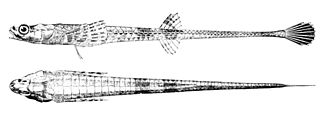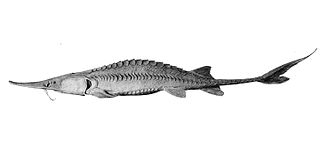
Cod is the common name for the demersal fish genus Gadus, belonging to the family Gadidae. Cod is also used as part of the common name for a number of other fish species, and one species that belongs to genus Gadus is commonly not called cod.

Mackerel is a common name applied to a number of different species of pelagic fish, mostly from the family Scombridae. They are found in both temperate and tropical seas, mostly living along the coast or offshore in the oceanic environment.

Pollock or pollack is the common name used for either of the two species of North Atlantic marine fish in the genus Pollachius. Pollachius pollachius is referred to as pollock in North America, Ireland and the United Kingdom, while Pollachius virens is usually known as saithe or coley in Great Britain and Ireland. Other names for P. pollachius include the Atlantic pollock, European pollock, lieu jaune, and lythe; while P. virens is also known as Boston blue, silver bill, or saithe.

The Percidae are a family of ray-finned fish, part of the order Perciformes, which are found in fresh and brackish waters of the Northern Hemisphere. The majority are Nearctic, but there are also Palearctic species. The family contains more than 200 species in 11 genera. The perches, and their relatives are in this family; well-known species include the walleye, sauger, ruffe, and three species of perch. However, small fish known as darters are also a part of this family.

Herring are forage fish, mostly belonging to the family of Clupeidae.

Mahseer is the common name used for the genera Tor, Neolissochilus, Naziritor and Parator in the family Cyprinidae (carps). The name is, however, more often restricted to members of the genus Tor. The range of these fish is from Vietnam in the east and China in the north, through Laos, Cambodia, Thailand, Malaysia, Brunei and Indonesia, and across southern Asia including the countries of India, Nepal, Bhutan and Bangladesh within the Indian Peninsula, plus Sri Lanka, Pakistan and Afghanistan. They are commercially important game fish, as well as highly esteemed food fish. Mahseer fetch high market price, and are potential candidate species for aquaculture. Several of the larger species have suffered severe declines, and are now considered threatened due to pollution, habitat loss, overfishing and increasing concern about the impacts of unregulated release of artificially bred stock of a very limited number of species.

"Sardine" and "pilchard" are common names for various species of small, oily forage fish in the herring family Clupeidae. The term "sardine" was first used in English during the early 15th century, a folk etymology says it comes from the Italian island of Sardinia, around which sardines were once supposedly abundant.

Carcharhiniformes, the ground sharks, are the largest order of sharks, with over 270 species. They include a number of common types, such as catsharks, swellsharks, and the sandbar shark.

The Squaliformes are an order of sharks that includes about 126 species in seven families.

The poachers are a family (Agonidae) of small, bottom-dwelling, cold-water marine fish. They are also known as Irish lords, sea ravens, alligatorfishes, starsnouts, hooknoses, and rockheads. Poachers are notable for having elongated bodies covered by scales modified into bony plates, and for using their large pectoral fins to move in short bursts. The family includes about 59 species in some 25 genera, some of which are quite widespread.

The flagtails are a family (Kuhliidae) of perciform fish of the Indo-Pacific area. The family consists of several species in one genus, Kuhlia. Most are euryhaline and often found in brackish water, but the genus also includes species restricted to marine or fresh water.

Arowanas are freshwater bony fish of the subfamily Osteoglossinae, also known as bony tongues. In this family of fish, the head is bony and the elongated body is covered by large, heavy scales, with a mosaic pattern of canals. The dorsal and anal fins have soft rays and are long based, while the pectoral and ventral fins are small. The name "bonytongues" is derived from a toothed bone on the floor of the mouth, the "tongue", equipped with teeth that bite against teeth on the roof of the mouth. The arowana is a facultative air breather and can obtain oxygen from air by sucking it into its swim bladder, which is lined with capillaries like lung tissue.

Sprat is the common name applied to a group of forage fish belonging to the genus Sprattus in the family Clupeidae. The term also is applied to a number of other small sprat-like forage fish. Like most forage fishes, sprats are highly active, small, oily fish. They travel in large schools with other fish and swim continuously throughout the day.

Sander is a genus of predatory ray-finned fish in the family Percidae, which also includes the perches, ruffes, and darters. They are also known as "pike-perch" because of their resemblance to fish in the unrelated Esocidae (pike) family. They are the only genus in the monotypic tribe Luciopercini, which is one of two tribes in the subfamily Luciopercinae,

Thunnus is a genus of ocean-dwelling, ray-finned bony fish from the mackerel family, Scombridae. More specifically, Thunnus is one of five genera which make up the tribe Thunnini – a tribe that is collectively known as the tunas. Also called the true tunas or real tunas, Thunnus consists of eight species of tuna, divided into two subgenera.

Scaphirhynchus is a genus of sturgeons native to the United States of America. All species in this genus are considered to be threatened. The pallid sturgeon is Endangered and the Alabama sturgeon is Critically Endangered.

Synanceia is a genus of ray-finned fish belonging to the subfamily Synanceiinae, the stonefishes, which is classified within the family Scorpaenidae, the scorpionfishes and relatives. Stonefishes are venomous, dangerous, and fatal to humans. They are the most venomous fish known. They are found in the coastal regions of the Indo-Pacific.

Semiplotus is a genus of cyprinid fishes found in south Asia.
Anoplagonus occidentalis is a fish in the family Agonidae (poachers). It was described by Georgii Ustinovich Lindberg in 1950. It is a marine fish which dwells in temperate waters, and is known from Japan, in the northwestern Pacific Ocean. It dwells at a depth range of 40–120 metres. Males can reach a maximum standard length of 10 centimetres.
Anoplagoninae is a subfamily of marine ray-finned fishes belonging to the family Agonidae, part of the sculpin superfamily Cottoidea. These fishes are found in the North Pacific Ocean.


















